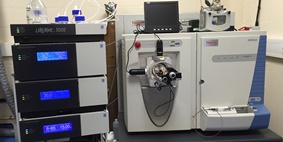ABRomics is an online community-driven platform to scale up and improve surveillance and research on antibiotic resistance from a One Health perspective.
ABRomics is an online community-driven platform to scale up and improve surveillance and research on antibiotic resistance from a One Health perspective.
UC6 : Proteomics for antibiotic susceptibility testing and molecular phenotyping of antibiotic resistant bacterial strains

Members
Coordinator :
C. Junot, Département Médicaments et Technologies pour la Santé (DMTS), CEA, INRAE, Université Paris-Saclay, F-91191 Gif-sur-Yvette, France
Team members :
National Reference Centers:
Proteomics:
Objectives and outcome
This use case aims to (i) develop an algorithm for integrating genomics and proteomics datasets, and modifying genome annotation with experimental peptide information, and prediction of proteotypic peptides for targeted proteomics measurements; (ii) submit high-quality, top-annotated experimental label-free proteome datasets for 120 referenced strains to the ABRomics database with their antibiotics susceptibility extensive characterization
Outcomes:
The identification of bacteria is currently essentially carried out in the clinical microbiology laboratory based on the mass profile of ribosomal proteins detected by MALDI-TOF mass spectrometry. However, although this approach is well suited for clinical isolates, it has strong limitations in cases of bacterial mixtures. It is often not suitable on biological samples without any culture step. It offers low performances for typing antibiotic resistant bacterial strains at the most resolved taxonomic level and does not give easy information on antibiotic resistances of the isolates. In this context, proteomics methods, based on the monitoring by liquid chromatography coupled to electrospray mass spectrometry of proteotypic peptides which can be inferred from genomic information stored in the ABRomics database could address these issues and provide relevant tools for antibiotic susceptibility testing. High-resolution targeted proteomics is a powerful approach to identify isolates and their expressed resistances, but requires to take into account the large heterogeneity of peptide sequences. Complementarily, untargeted discovery proteomic analyses (shotgun proteomics) could improve the structural annotation of bacterial genes involved in antibiotic resistance and strengthen the proteotypic peptide prioritization. The data (targeted proteomics, shotgun proteomics) will be supplied in the ABRomics database for a large dataset of relevant isolates. Specific bioinformatics tools will be developed for exploiting these data.
Two complementary tasks will be undertaken from data stored in the ABRomics database: (i) automated exploitation of gene sequencing data for the design of targeted and quantitative proteomic methods for antibiotic susceptibility testing, and (ii) Proteogenomics insights into antibiotic gene resistance and virulence.
1. Automated exploitation of gene sequencing data for the design of targeted and quantitative proteomic methods for antibiotic susceptibility testing.
The aim is to perform a concordance analysis between proteomics and antibiograms for extended-spectrum beta-lactamase in clinical strains representative of epidemiology. Indeed, ESBL resistance mechanisms show a very high allelic variability since several hundreds of protein isoforms are described combining the CTX-M, SHV et TEM families. Precise detection and quantification of each ESBL variant by a proteomics technology in strains collected either in a clinical setting or in the environment requires the development of a dedicated algorithm. The first stage of this algorithm development will be to list proteotypic tryptic peptides amenable to mass spectrometry detection.
2. Proteogenomics insights into antibiotic gene resistance and virulence.
The aims are to improve antibiotic gene resistance and bacterial genome annotation by proteogenomics data, and to predict expressed proteome profiles from any theoretical genome and detection of abnormal experimental protein profiles. Systematic search of peptides in experimental proteomic datasets could reinforce the annotation of genes and their appropriate delineation (Hartmann & Armengaud, 2014). A specific pipeline to confront pan-genomics data and pan-proteomics data should be specifically developed. The resulting improved annotated database will help for detection of pathogens and automatic characterization of their expressed resistances.
Deliverable 1: prediction of proteotypic peptides for detectability of antibiotic resistance proteins and virulence factors
Deliverable 2: a Standard Operating Procedure for proteomics datasets submission and proteogenomics interpretation